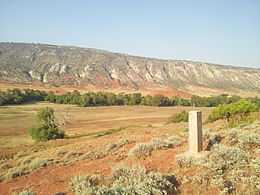Dull Knife Fight
| Dull Knife Fight | |||||||
|---|---|---|---|---|---|---|---|
| Part of the Great Sioux War of 1876 | |||||||
| |||||||
| Belligerents | |||||||
| Cheyenne |
| ||||||
| Commanders and leaders | |||||||
|
Dull Knife Little Wolf |
| ||||||
| Strength | |||||||
| ~400 | ~1,000 | ||||||
| Casualties and losses | |||||||
|
30 killed unknown wounded |
9 killed 26 wounded | ||||||
The Dull Knife Fight, or the Battle on the Red Fork, part of the Great Sioux War of 1876-77, was a battle that was fought on November 25, 1876 in present day Johnson County, Wyoming between soldiers and scouts of the United States Army and warriors of the Northern Cheyenne. The battle essentially ended the Cheyennes' ability to wage war on the Great Plains.
Background
After soldiers from Fort Fetterman in Wyoming Territory under Brigadier General George Crook fought the Northern Cheyenne's at the Battle of Powder River, on March 17, 1876, the Battle of Prairie Dog Creek on June 9, 1876, the Battle of the Rosebud on June 17, 1876, and the Battle of Slim Buttes on September 9-10, 1876, General Crook received reinforcements at his Goose Creek, Wyoming supply base and began to move up the old Bozeman Trail towards Crazy Horse. After learning of a village of Cheyennes in October, 1876, Crook sent Colonel Ranald S. Mackenzie into the Southern Powder River Country to locate it.
Colonel Mackenzie departed Camp Robinson, Nebraska with nearly 1,000 soldiers in 11 companies of the 2nd, 3rd, 4th, and 5th United States Cavalry Regiments. He also had a large contingent of Indian scouts, including Pawnee, Shoshone, Arapaho, Lakota, and Cheyenne.[2]
The battle
Eventually on November 25, 1876, Mackenzie found the camp of about 400 Cheyenne's in 173 tepees under Dull Knife and Little Wolf on the Red Fork of the Powder River. The Cheyenne warriors were having a celebration because of a recent victory over the Shoshone Indians. Mackenzie waited until dawn, then attacked and drove the warriors from the village. Some were forced to leave their clothes, blankets and buffalo robes behind and flee into the frozen countryside. Dull Knife began to offer stiff resistance, and savage fighting continued. The Pawnee warriors accompanying the soldiers fought with exceptional ability against the Cheyenne's. Second Lieutenant John A. McKinney, of the 4th United States Cavalry Regiment, and five enlisted men were Killed in action. Chief Dull Knife's Cheyenne warriors finally retreated, abandoning their village.[3] The Cheyenne village of 173 lodges and all its contents were entirely destroyed, and the soldiers captured about 500 Indian ponies.
Aftermath
The Dull Knife Fight ended the Northern Cheyenne's resistance to the United States for all practical purposes. Dull Knife's followers were left in the freezing November weather without sufficient clothing, and many suffered from frostbite. A large number of Dull Knife's band traveled north along the Bighorn Mountains, eventually reaching the upper Tongue River regions. Some joined Chief Crazy Horse's Oglala Sioux camp on Beaver Creek, and on January 8, 1877, would fight alongside Crazy Horse and Two Moon at the Battle of Wolf Mountain on the banks of the Tongue River, in Montana Territory.[4]
Order of battle
Native Americans, Chief's Dull Knife, and Little Coyote (Little Wolf). About 400 warriors.
| Native Americans | Tribe | Leaders |
|---|---|---|
| Northern Cheyenne
|
| |
United States Army Expedition from Camp Robinson, Nebraska, October-November, 1876, Late Major General, Colonel Ranald S. Mackenzie, commanding.
| Expedition | Regiment | Companies and Others |
|---|---|---|
|
|
2nd Cavalry
|
|
| 3rd Cavalry
|
| |
| 4th Cavalry
|
| |
| 5th Cavalry
|
| |
| Indian Scouts and Guides
|
Dull Knife battlefield

The Dull Knife Battlefield is located east of the Bighorn Mountains in Johnson County, Wyoming near the present day town of Kaycee, Wyoming. The battlefield is on private land and tours are available only by special arrangement. The location is now the site of a Cattle ranch.
Notes
- ↑ "Bates Creek". Geographic Names Information System. United States Geological Survey.
- ↑ Grinnell, George B.: The Fighting Cheyennes, p. 351.
- ↑ Junge, Mark (July 6, 1979). "National Register of Historic Places Inventory - Nomination Form: Dull Knife Battlefield" (PDF). National Park Service. Retrieved 2009-08-05.
- ↑ Grinnell, George B.: The Fighting Cheyennes, p. 368.
References
- Dillon, Richard H. North American Indian Wars (1983)
- The Great Sioux War 1876-1877: Dull Knife Battle
- Chronological History of Engagements